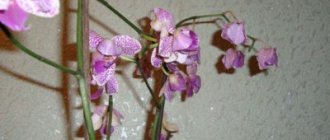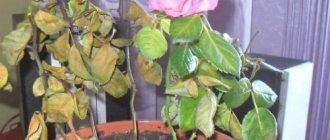Exotic cultures add zest to the interior of any room. Orchids convey an indescribable atmosphere of the tropics. The most popular varieties for home cultivation are dendrobium, phalaenopsis, paphiopedilum, and cattleya. There are a lot of nuances in caring for capricious exotics. The most common flower problem is yellowing of the leaf blade. The question of why orchid leaves turn yellow is asked by both beginners and professionals in the flower business. Next, we will consider the causes and methods of eliminating yellowing.
Orchid description, photo
An orchid during its flowering period stuns with its beauty and aesthetic appearance. In addition, there are varieties that have a pleasant aroma. The variety of shapes and colors amazes with splendor and luxury. This plant represents one of the largest families of flower crops. According to various sources, the family has 17-30 thousand varieties.
The distribution area of the culture covers the territory from the Arctic to the tropics. The greatest concentration of plants is observed in Asia, New Guinea, Central and North America. Flowers grow in moist forests in mountainous areas. Only certain varieties prefer the dry and hot climate of savannas.
This culture is diverse in shape, size and lifestyle. Representatives include lianas, terrestrial plants and epiphytes. Domesticated varieties are often epiphytic or epilithic crops. The bushes have an aerial root system covered with spongy matter made from dead, oxygen-filled cells. They absorb life-giving moisture and air. Some species have green roots that contain chlorophyll and are capable of photosynthesis.
blooming orchid at home
Most epiphytic varieties have a swollen, thickened stem - a bulb (tuberidium). It is able to accumulate nutritional components during the rainy season, and with the onset of the dry season, it feeds the flower with the collected reserves. Terrestrial representatives accumulate reserves in roots or underground tuberidia.
The orchid flower deserves special attention. Depending on the species, the buds surprise with a riot of colors and shapes. 419 varieties are cultivated in Russia. Recently, breeders have developed many hybrids adapted for breeding in greenhouses and apartments. However, the flower retains its natural needs at the genetic level. Therefore, it is important to create the most natural climatic conditions for growing orchids at home.
Informative! In the wild, orchids can live up to 100 years, and at home about 30 years.
Root system rotting or drying out
Yellowing of orchid leaves in the middle of the trunk or at the top may largely indicate rotting or drying of the root system . There is an urgent need to find out the reason for this process.
If this is associated with fungal diseases, then an emergency transplant with treatment of the roots with a fungicide is required. Drying can be caused by a lack of moisture due to strong soil compaction.
Any changes in the development of an orchid are mainly associated with problems of the root part , which requires increased attention and full care.
Why do orchid leaves turn yellow?
Indoor flowers delight their owners with lush and colorful blooms. But sometimes they get sick. A common problem is yellowing and wilting of foliage. Any negative changes in the appearance of a flower are a bad signal. Dry foliage is dangerous because the nuisance can affect the condition of neighboring crops. Many people do not take into account changes in the color of the foliage and, as a result, the disease or unfavorable living conditions continue to destroy the bush, and time for rehabilitation will be lost. There may be several reasons for this phenomenon.
Natural causes
It is not always worth raising the alarm when the color of greenery changes. The leaf may turn yellow due to the natural aging process. This change in greenery occurs in each variety. In hybrids (for example, phalaenopsis), the lower leaf always dries out. Rarely does a pair of shoots turn yellow. In the Dendrobium nobile variety, the bush can completely shed its greenery, both during the flowering period and after.
Age also affects greens - it is extremely rare for greens to retain their original appearance for a long time. Annual renewal of shoots during the flowering period and during the dormant stage is the norm for this species and has a certain frequency:
- once a year;
- Twice a year;
- once every 5 years.
Also, the cause of color loss can be the wrong neighborhood. It is not recommended to grow plants such as araucaria, cordyline, yucca, and peperomia in close proximity. With proper maintenance, gardeners rarely have problems with orchids. However, if any requirements are violated, the flower immediately reacts by changing its shade or slowing down its growth.
Improper care
The main and most common reason why a leaf begins to turn yellow is improper watering. Excess, as well as lack of moisture, leads to metabolic disorders. Beginners in floriculture often overwater a delicate plant. The harm from such actions consists of dense soil that does not allow air to pass through, the process of rotting roots and the attachment of pathogenic bacteria. Experienced gardeners recommend focusing on the middle layers of soil when watering. The upper crust dries out quite quickly and misleads beginners.
Orchid leaves turn yellow due to improper care
If an indoor flower grows in a transparent container, then there will be no problems determining soil moisture. When using opaque pots, you can use a wooden stick (if it becomes wet when placed in the ground, then it is too early to water).
For your information! You can determine the dryness of the substrate by weight - wet soil is always heavier.
Poor quality or incorrectly selected substrate for a particular species can cause greenery to wither. Dense, non-breathing soil is also a factor in yellowing and wilting. Lack of air circulation and soil compaction provokes stagnation of moisture and the development of fungal infection. Greenery is the first to react to changes and signals the owner about a problem.
Timely replacement of the soil, the correct mixture for each type of orchid and the correct location of the pot guarantees getting rid of possible deviations in the development of the crop. The influence of direct sunlight and the presence of pots near heating devices leads to overheating of the root system and excessive evaporation of moisture from the soil.
The temperature of rhizomes and shoots becomes different, which causes a stop in the circulation of nutrients. The consequence of such changes is a change in the color of the greenery and loss of turgor. The situation can be corrected by timely moving the container with the flower to a more suitable place.
As you know, foliage is involved in photosynthesis processes, so lack of lighting has a detrimental effect on the development phases. Too much light is also harmful to the bush. The crop needs periods of rest (sleep), and using improper additional lighting can cause the plant to overheat. For proper development, orchids require 10-12 hours of daylight.
a yellow spot on an orchid leaf is the result of sunburn
Interesting! The use of phytolamps will help provide the crop with the necessary quantity and quality of light throughout the year.
Prevention techniques
Proper care of orchids and the necessary maintenance conditions will help prevent unwanted yellowing of leaves and diseases. With mandatory consideration of the characteristics of each type :
- Maintain the recommended temperature : In summer - 23-28 degrees;
- In winter 15-19 degrees;
- Monitor the difference between day and night temperatures. It should not exceed 4-5 degrees.
For an orchid, it is necessary to ensure the correct temperature conditions.
Leaves turn yellow after transplanting
A freshly purchased plant must be replanted at the end of flowering or a year after purchase. Sometimes a transplant needs to be carried out earlier than the specified dates. For example, if the rhizomes of the flower filled the entire space of the pot and began to climb out, or the substrate stratified ahead of time. After a change of residence, the shoots may begin to turn yellow. Such consequences may indicate that the soil or pot size is incorrectly selected, or that the flower is not cared for properly.
Before you start transplanting any type of exotic flower, you should study the relevant information or seek advice from experts. This culture is very delicate and vulnerable and all manipulations with it should be carried out with extreme caution.
During the transplantation process, it is necessary to pay attention to the condition of the plant roots. If dry, rotten or injured roots are found, they must be removed. Otherwise, the bush will die due to progress in rotting or drying out of the roots. In order to avoid making disastrous mistakes, the transplantation procedure should be carried out according to the clear recommendations of experienced gardeners.
Why is it important to start treatment as early as possible?
It is advisable to start treating any disease early. Don't run :
- The affected areas are not that large;
As soon as the orchid leaves begin to turn yellow, treatment must begin immediately. - You can prevent damage to other areas and parts of the plant. And protect other orchids nearby if you are isolating sick ones;
- It is less painful for the plant to remove part of the leaf than if you proceed to the stems and roots.
Let's take a closer look at what to do if the orchid's leaves turn yellow.
Leaves wither and turn yellow
The shoots begin to wither and change color with loss of turgor. Healthy shoots are thin, smooth, with a brightly colored bud. Softening of turgor is a certain indicator of foliage health, which subsequently leads to yellowness. There are many reasons for this condition. The main ones are improper care and atypical living conditions. A particularly common mistake in care is indiscriminate watering and violation of air humidity.
If the greenery of an adult bush turns yellow only once, then nothing needs to be done. This is a natural process of cultural growth. However, when yellowness causes concern, the cause of the disease should initially be identified. To do this, information about a specific variety is studied in detail, and the required growing conditions are created.
yellow orchid leaves
If most of the greenery suffers, the plant needs help. In some cases, it is advisable to abandon flowering and transplant the bush into a fresh substrate, treating the rhizomes from diseases and damage. Yellowness indicates a lack of adequate nutrition in the leaf.
In such situations, it should be understood that the damaged process can no longer be restored. Removal also will not always eliminate the disease. Often the problem lies in the stems or rhizome. Any infectious disease loves a humid environment. In this regard, the soil should initially be dried and then treated with antibacterial and antifungal agents.
Remember! Improper watering accounts for 80% of all possible problems with growing orchids.
Excess fertilizer also leads to wilting and falling leaves. It is important to select the right nutritional complexes and strictly follow the manufacturers’ recommendations when applying fertilizers. Abuse of growth stimulants and nitrogen fertilizers provokes an acceleration of the growth and aging processes of the bush. Consequently, the replacement of old shoots with new ones occurs faster. After all, the plant is under the influence of artificial drugs, therefore it sheds its leaves faster.
How to save if they lose turgor, turn yellow and fall off?
If the orchid leaves not only begin to turn yellow, but also fall off, then the plant must be urgently revived:
Analyze the conditions of the flower and identify possible causes of the problem.- Change the mode and methods of watering.
- Move the flower pot to another place.
- If the orchid is located next to yucca, peperomia, cordilina or ararkaria, then it is necessary to move them away.
- Replace soil and pot. A new pot must be disinfected with a solution of potassium permanganate before planting.
- Do not use fertilizers or growth stimulants for at least 14 days.
- If fungal or bacterial diseases are detected on the orchid, it must be treated with fungicides.
Important! Only soft water should be used for irrigation.
The tips of the leaves of the dendrobium orchid turn yellow
Yellowing of the tips of the shoots is not observed so often. This color change is observed when there is an excess of sunlight or calcium in the substrate. If you do not make adjustments to the crop's nutrition and do not adjust the lighting, over time the entire shoot becomes yellow. Dendrobium is very susceptible to both lack of nutrition and an excess of microelements in the soil. It is extremely dangerous to overfeed a flower at an early stage of development.
The crop is mainly purchased in flower shops, where sellers, in order to prolong bright and dense flowering, saturate the substrate with various growth stimulants and fertilizers. After a couple of years of such existence, such bushes become depleted and die. In this regard, it is not recommended to feed a freshly purchased plant. And after maintaining the quarantine period, it is worth replanting the new flower into a fresh substrate and a new container.
Recently, an equally common problem why a leaf changes its color is the excess amount of calcium in the substrate. This is caused by soil salinity, which prevents the crop from absorbing iron. In this case, the system of supply of mineral components is completely disrupted. The shoots become dull, the tips turn yellow and curl. The edges of the platinum become torn. Young shoots react especially strongly to this. In such a situation, it is necessary to save the flower - urgently replant it by washing the roots under running water.
Advice! Until the bush is completely restored, it is recommended to exclude any additional feeding with calcium-containing complexes.
Low air humidity also causes the edges of the sheet platinum to dry out. It is important to remember that the natural climate of orchids is famous for high air humidity, and the dry climate of an apartment will destroy the delicate plant. In rooms with dry air, the crop always begins to dry out from the tips of the leaves. Using a humidifier or irrigating the bush with a spray bottle will help restore vitality and attractive appearance to the plant.
Drying roots is one of the reasons for yellowing
How to save an orchid if the roots have dried out? Often, novice gardeners make the common mistake of drying out the roots. As a result, the leaves turn yellow. Naturally, lack of nutrition provokes yellowing of the leaves. Drying of the root system can also occur due to:
- Thermal burn from hard water;
- Or an overabundance of concentrated fertilizers.
The roots of an orchid may dry out due to lack of moisture.
The aerial roots of some orchid species can dry out due to low humidity , which is unusual for them due to their genetic disposition. Less commonly, this problem is associated with injuries and advanced infectious diseases.
Adjusting care comes down to restoration, and sometimes even resuscitation, of the root system . The root part is immersed in water until the roots are completely saturated with moisture. Then the excess water is drained, and the immersion process is repeated after 5-7 days. This procedure is carried out until the root system is completely restored.
The leaf plates are also fed with nutrients. Experienced orchidists recommend using :
- Succinic acid;
- And nutritional shakes.
with potassium-phosphorus fertilizers gives good results , but carefully and no more than once every 20 days.
The lower leaves of the phalaenopsis orchid turn yellow
If only the lower leaf turns yellow, then there is no need to rush into treatment. The leaf will dry out and fall off on its own without causing harm to the plant. This is a consequence of the natural processes of growth and renewal of greenery. By cutting or tearing off such a process, you can cause injury to a delicate exotic plant.
The lower leaves of the orchid have turned yellow
Improper care also affects young shoots. An externally healthy plant may change the color of its shoots. The reason may be the chosen method of moistening the soil. When watering from a watering can, the bark is poorly moistened, because all the moisture quickly leaves the pot through the drainage, without having time to nourish the roots. It is recommended to use the submersible irrigation method. A couple of weeks after changing the watering regime, the flower will return to normal.
When should you worry?
As noted above, orchid leaves may turn yellow at the base or completely and fall off due to natural reasons.
Attention! If, in addition to yellowness, other symptoms indicating a disease appear, this should cause concern to the grower.
Such symptoms indicating that the plant is sick or the conditions of its maintenance have been violated include:
- The appearance of signs of rot on roots, leaves and stems.
- Weeping spots on leaves and stems.
- Drying.
- Withered leaves.
- The lower tier of leaves or one side of the plant has completely turned yellow.
- The appearance of brown spots on leaves and stems.
Leaves turn yellow at the base
The leaf can turn yellow not only if care standards are not followed, but also depending on the type of orchid. In Dendrobium, for example, at the end of flowering, the stem and shoots completely die off. But after a couple of days, new young shoots grow in its place. In Falik, yellowing is observed due to frostbite, loss of growth points, compaction of the substrate, etc. This is not a natural process, so the cause should be found out and treatment should begin as soon as possible. The base of the leaf begins to die off when the disease is advanced or the plant maintenance standards are violated.
the leaf at the base of the orchid turns yellow
Yellowing of the leaves at the base may indicate rotting or drying out of the root system. And such a problem requires urgent resolution. The presence of a fungal infection can lead to rotting of the rhizomes. Then the orchid must be urgently replanted and the roots treated with fungicides. Drying of roots is often associated with a lack of moisture due to compaction of the substrate. All problems associated with changes in the root system require urgent and immediate solutions.
Also, a change in color in the middle of the bush may indicate insufficient daylight hours. The process of photosynthesis plays an important role in the development of the plant, therefore, in the absence of light, the flower becomes weak and unviable. The greenery wilts in the middle - these are the places where the least amount of sunlight gets. To eliminate the problem, it will be enough to move the pot to a more illuminated room or provide additional lighting.
Important! If the plant is in the active growth phase, then any movement of the pot should be avoided and the location of the crop should be changed.
.
Negative effects of saline substrate and poor quality water
Water for irrigation should be soft, since in its homeland the flower receives moisture from the air.
You need to know what kind of water to water your orchid.
In almost all regions of Russia, the water is quite hard, so it must be softened in various ways :
- Collect rainwater;
- Boiling;
- Use distilled water;
- Use different filters.
With hard water, the bark will become salty and the roots will stop absorbing moisture. As a result, the flower will die. It is necessary to water orchids properly so that the orchid leaves do not turn yellow or fall off.
IMPORTANT! The flower requires soft water for irrigation.
The leaves of a blooming orchid turn yellow
During the flowering period, a problem with yellow leaves can arise if the conditions of the crop are violated. Some species completely shed all their greenery during the flowering period. This is a normal natural process, so there is no cause for concern. In other cases, if a flowering bush loses its greenery, it is important to determine the cause of this phenomenon. Please pay attention to:
- irrigation regime;
- quality and quantity of lighting;
- water indicators;
- fertilizing
The flower sheds its foliage when the shoots turn yellow massively, because there is a significant decrease in nutrition and photosynthesis. Further actions depend on the severity of the disease. If the plant is kept in the right conditions and there is no presence of infection, the yellowness of individual shoots does not have a negative effect on the crop as a whole.
If the reason lies in other problems, then at the same time as the shoot changes color, the bush sheds its buds. With a weakened root system, the greens begin to wither immediately after flowering. Additionally, a lack of moisture in the roots leads to yellowness, because the rhizomes begin to draw life-giving nutrition from the shoots, which leads to a change in color.
It is extremely important to organize proper care after flowering. Maintain the required temperature and watering conditions. And also carry out proper pruning of the shoots. After the first couple of flowerings, the flower should be transplanted into a new large container with fresh nutrient substrate.
Long-term consequences
If measures are not taken in time, the beautiful orchid may stop blooming, dry out, or the process of rotting may begin, which will ultimately lead to the death of the entire plant.
If the cause of yellowing leaves is an infection, then unless appropriate measures are taken, there is a risk of the disease spreading to other plants.
What to do with yellowed leaves
The yellow sheet is not removed until it is completely dry. The sprout, which has not yet dried out, continues to nourish the plant. During the natural process of changing greenery, the flower itself sheds its dried leaves. If only part of the plate has changed color, then the bush will be able to provide the healthy half with nutrients.
If yellowness appears under the influence of fungal and infectious diseases, they initially try to revive the crop by treating the bush with special preparations and replanting, without removing the injured shoots.
orchid leaf turned yellow infectious disease
You can also remove dried shoots during the replanting process. It is with this procedure that there is an excellent opportunity to remove all damaged and injured parts of the plant. If you replant the crop early, then an important condition for removal is checking the drying phase. The sheet is removed only after complete drying, and this process may take some time.
Often the foliage of a flower is not cut off, but carefully broken off. The shoot is taken by the base and torn into two halves along the central groove. This procedure must be performed with extreme caution so as not to harm the trunk and root system. In case a fresh wound has formed on the stem after the fall, this area should be treated with crushed coal. The correct procedure for removing a sheet can be seen in the video.
Recommendation! After removing the shoots, it is better to refrain from watering for 2-3 days.
If the bush has suffered from a pest attack or an associated disease, then the crop should be treated. Having diagnosed the exact cause, you can choose an effective way to save the flower.
Lack of lighting
Why did the orchid leaves turn yellow and fall off? In winter and autumn, when the weather is cloudy in all regions, orchids lack sunlight . At this time, the leaves lose their color. They do not turn yellow, but they seem to fade in comparison with summer.
To prevent this fade from turning yellow, the plant needs lighting on cloudy days . After all, for normal development, a flower needs 8-10 hours of light. In poor lighting, the buds also dry out, since the flower does not have enough strength to open them.
Therefore, those who do not have southern window sills should purchase phytolamps in specialized stores. They will help cope with the lack of lighting .
IMPORTANT! Phytolamps are placed at a certain distance from the plants so as not to cause a thermal burn on the body of the orchids.
Useful care tips
Several useful tips for caring for Felonopsis will help you avoid common mistakes common to novice gardeners:
- You should not water the orchid in the evening, this can cause hypothermia of the roots and lead to the development of fungus;
- You cannot use unsettled tap water for irrigation, as this leads to salinization of the root system, after which it will not be able to properly absorb moisture;
- do not place newly acquired flowers next to old-timers, this can lead to infection of all plants;
- monitor the basic characteristics of the microclimate and comply with them (light, watering, temperature and humidity, fertilization).
It will be useful for you to read how to care for a phalaenopsis orchid after flowering.
Having the necessary theoretical knowledge, creating optimal conditions for the normal growth and development of an orchid is quite simple, although you will have to work a little. But, as compensation for your efforts, you will be able to grow a beautiful, healthy flower that will delight you and your loved ones for a long time.











